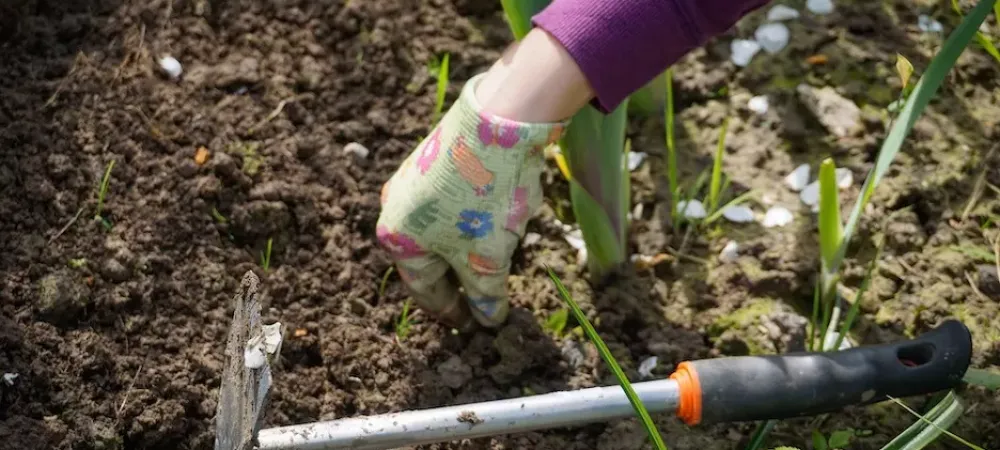How To Keep Weeds Out Of Your Flower Bed

No one wants to find weeds in their beautiful flower beds. Not only are weeds not pleasing to the eye, but they can also compete with your flowers for resources such as light, water, and nutrients. To help protect your plants and flower beds, consider these different methods to keep your flower beds weed-free:
Hand-Pulling Weeds
One of the most effective ways to get rid of weeds is by manually pulling them out of your flower bed by hand. It is important to pull out the entire plant at the root to ensure the weeds don’t just re-sprout.
Here are some helpful tips for pulling weeds in your flower bed:
- Pull weeds when the soil is moist: Weeds are easier to pull when the soil is moist, so try to do your weeding after a rain or irrigation or after watering your flower bed.
- Use the right tools: A hand trowel or a small garden fork can make it easier to pull weeds. Make sure the tool has a sharp edge to help break up the soil and loosen the roots.
- Pull weeds by the root: To prevent weeds from growing back, make sure to pull them out by the root. If the roots break off, the weed will continue to grow.
- Be consistent: Weeding is most effective when done regularly, so try to check your flower bed for weeds at least once a week and pull any that you find.
- Use gloves: Wearing gloves will protect your hands from dirt and any potential irritants or poisonous plants.
- Dispose of weeds properly: Once you've pulled the weeds, make sure to dispose of them properly, such as by placing them in a compost pile or sealed plastic bag.
- Target the young and small weeds: The young and small weeds are easier to pull and have less established root systems, so focus on them before they grow bigger and harder to remove.
By consistently following these steps, you can help keep your flower bed free of weeds and allow your flowers to thrive.
Installing Landscape Fabric
Landscaping fabric is a heavy-duty woven material that is placed on the ground and covered with a layer of mulch or decorative stone. It works by blocking sunlight and preventing weed seeds from germinating, while still allowing water and air to penetrate through to the soil.
The fabric should be placed on the soil surface and then covered with a layer of mulch or decorative stone. This will help to weigh it down and prevent it from being displaced by wind or other factors. It is important to note that if you are planning to use landscape fabric in flower beds, you should install it before planting. Once the fabric is in place, it will be difficult to make changes to the bed without disturbing the fabric.
It's important to note that landscape fabric is not a permanent solution and it will need to be replaced over time. As fabric gets older, it will break down, and the sunlight will still be able to penetrate through. Moreover, if the fabric is not installed correctly, or not overlapped and sealed properly, weeds will still be able to grow through. Therefore, it's essential to maintain the flower bed regularly, by pulling out any weeds that may grow through the fabric.
Mulching
Mulch can also be used to keep weeds from growing in flower beds by creating a physical barrier that blocks light and prevents weed seeds from germinating. Here's how it works:
- Mulch is spread over the soil in the flower bed, typically to a depth of 2-3 inches.
- The mulch creates a barrier on top of the soil that blocks light from reaching weed seeds. Without light, the seeds are unable to germinate and grow.
- The mulch also helps to retain moisture in the soil, which can make it more difficult for weeds to establish roots and grow.
- Organic mulches like wood chips, bark, or leaves will decompose over time, enriching the soil with beneficial microorganisms and organic matter.
- Regularly topdressing the mulch will keep the barrier thick and effective in preventing weed growth.
It's important to note that mulch should not be applied directly against the base of plants or trees as it can cause rot or encourage pests and diseases.
Proper Watering and Fertilization
Proper watering and fertilization can help to prevent weeds from growing in flower beds by promoting healthy growth of your plants, which in turn can help to crowd out weeds. Here are a few tips for proper watering and fertilization to keep weeds out of flower beds:
- Watering: Water your flowers and shrubs deeply and infrequently, rather than shallowly and frequently. This encourages deep root growth, which helps to make your plants more drought-tolerant and less likely to be outcompeted by weeds.
- Fertilization: Use a slow-release fertilizer that provides a steady supply of nutrients to your plants, rather than a quick-release fertilizer that can cause a flush of growth that is quickly outcompeted by weeds.
- Right timing: Fertilize your plants at the right time of year, according to the specific needs of the plant species.
- Right amount: Follow the recommended application rates for fertilizers, and avoid over-fertilizing, which can lead to weak, spindly growth that is more easily outcompeted by weeds.
By following these tips, you can ensure that your plants are healthy and vigorous, which will make them more able to compete with weeds for resources such as light, water, and nutrients.
Applying DIY Herbicide
Natural herbicides are a great way to get rid of weeds. Some of the most common options include:
- Vinegar: A solution of vinegar and dish soap can be sprayed directly on weeds to kill them. The acetic acid in the vinegar acts as a natural herbicide and will dry out the leaves and stems of the weeds, causing them to die.
- Salt: Salt can be used to create a DIY weed killer. Mixing 1 cup of salt with 2 cups of boiling water and pouring it directly on weeds can be effective in killing them.
- Baking soda: Mix 2 tablespoons of baking soda with 1 gallon of water and spray it on the weeds. Baking soda raises the pH of the soil, which makes it difficult for weeds to grow.
- Lemon juice: Lemon juice contains citric acid, which can be used to kill weeds. Mix equal parts of lemon juice and water, and spray it directly on the weeds.
- Soap and water: Mixing 1 tablespoon of liquid soap with 1 gallon of water and spraying it on the weeds can be effective in killing them.
- Boiling water: Pouring boiling water directly onto weeds can be effective in killing them, as the heat will damage the cells of the plant.
It's important to note that while these DIY treatments may be effective in killing weeds, they can also harm desirable plants if not used properly. Be sure to test a small area first.
Using Chemical Herbicides
As a last resort, chemical herbicides can be used to control weeds in flower beds, but it is important to use them carefully and according to the instructions on the label. Some common types of herbicides used for this purpose include glyphosate (Roundup), triclopyr (Garlon), and 2,4-D. These herbicides work by killing weeds, either by preventing them from growing or by killing the roots.
It's important to note that most herbicides are non-selective, meaning that they will kill any plant they come into contact with, including flowers, so it is important to apply them carefully, avoiding the flowers.
It's also important to consider the potential risks and drawbacks of chemical herbicides, such as harm to beneficial insects and pollinators, groundwater contamination, and potential human health hazards. Therefore, it's always best to start by using non-toxic alternatives, such as hand-weeding, mulch, or physical barriers, or using selective herbicides, which are designed to target specific types of weeds and not harm the desirable plants.
Get Professional Bed Weed Control
If you are having trouble keeping your flower beds weed-free, consider calling in the professionals. All team of experienced lawn technicians provides bed weed control to communities throughout Western Tennessee and Southeastern Missouri. Contact our team today to learn more!
